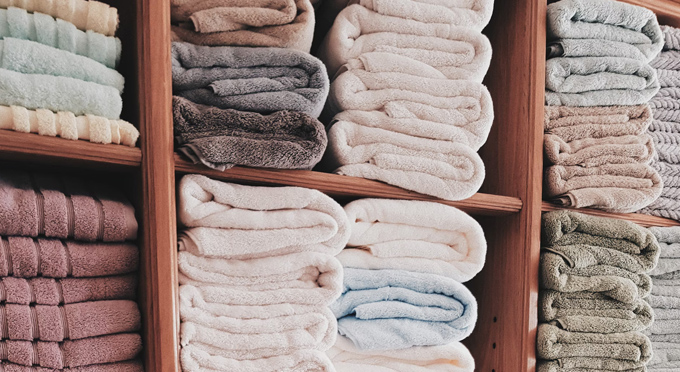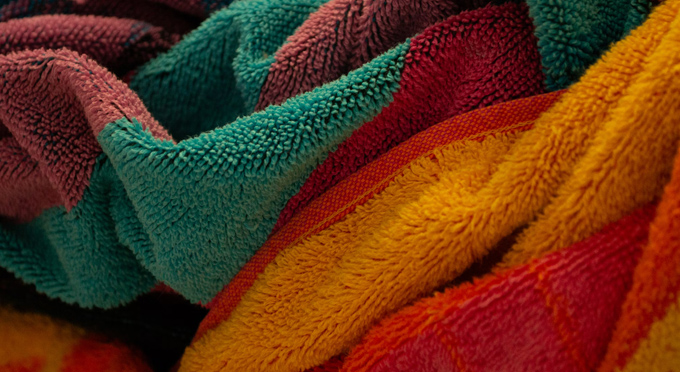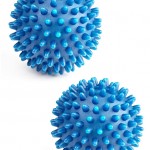
It’s pretty well known that traditional fabric softeners can cause problems for certain items, so it’s no surprise that a customer wrote us concerned that they may have ruined a cleaning cloth by washing it with fabric softener. Although repeated use will reduce absorbency and cause other performance problems for cloths and towels, a single use will not be the end of the world.
You don’t need to throw out your microfiber cloth or shammy after a single exposure to fabric softener, but you should consider an alternative because using it every time you do the laundry will cause trouble over time. Continue reading below to learn why liquid softeners and dryer sheets cause fabrics to absorb less moisture, then keep on reading to find out how you can prevent the problem, and lessen the side effects.
Question:
I washed my shammy and forgot and used fabric softener. Did I ruin it ?
Answer:
Good question. We always recommend against using traditional fabric softeners with shammys and other cleaning cloths because it will affect its ability to clean and soak up moisture over time.
For those unfamiliar, a shammy is a non-woven, synthetic cloth known for its incredible ability to absorb moisture and lock it in. The main side effect to using dryer sheets or liquid softeners on towels and other items is a decrease in absorbency. The good news in this case, is that a single exposure will not render the cloth ineffective, but with continued use, it definitely will not work as well. Don’t go tossing your cleaning cloth in the trash just yet, because that shammy should still be able to suck up incredible amounts of water.
Why This Happens
Traditional fabric softeners contain a mix of chemical compounds and perfumes, along with other ingredients. When added to your laundry they will completely coat the fabrics, in order to soften them and add that familiar pleasant scent. Much will be eliminated by rinsing, but some will always remain.
For materials like microfiber and viscose shammys, this action will result in clogged pores, blunted ends, and residues that linger. When the material can’t function as intended, you end up with a tool that is less absorbent, or less able to pick up dirt. As previously stated, a single dose will not cause much harm, but build up over time is guaranteed to make your shammy, bath towel or cleaning cloth noticeably less effective.

Fabric softeners can have a negative impact on the absorbency of certain textiles, particularly towels and other fabrics designed to absorb moisture. Although absorbency is the main characteristic affected, using traditional laundry products can cause other harm too. Here’s how fabric softeners affect absorbency and other stuff to ruin your towels and cleaning cloths over time:
- Coating Fabric Fibers: Fabric softeners work by depositing a thin layer of lubricating chemicals on the surface of fabric fibers. This coating softens the fabric and reduces static electricity. However, it can also clog the tiny pores and spaces between the fibers that are responsible for absorbing moisture.
- Reduced Absorbency: The chemical coating created by fabric softeners inhibits the fabric’s ability to absorb moisture effectively. When you use fabric softener on towels, for example, it can create a water-resistant barrier that prevents the towels from soaking up as much water.
- Residue Buildup: Over time, repeated use of fabric softeners can lead to a buildup of residues on fabric fibers. These residues can further reduce the fabric’s ability to absorb moisture and may create a waxy or slimy feel.
- Impact on Microfiber and High-Tech Fabrics: Fabric softeners can be particularly detrimental to high-tech and microfiber fabrics, which rely on their specific texture and structure to wick moisture away from the skin. Fabric softener can disrupt these properties, rendering the fabric less effective in moisture management.
- Decreased Lifespan: The buildup of fabric softener residues can also lead to fabric deterioration over time. Fabrics may become less durable and more prone to damage, reducing their overall lifespan.
Fabric Softener Ingredients
More that your ability to soak spills, or dry your body, you should be concerned with the ingredients you are exposing yourself to on a regular basis. The substances in liquid softeners and dryer sheets can absorb into your skin, or be inhaled into your lungs. Because there is some pretty dangerous stuff in there, you should think twice about adding it to any load, not just towels.
Safe and natural alternatives such as dryer balls or vinegar, can soften fabric just as well, but they will not effect absorbency ever. You won’t get any of the perfume scent, but for many people that is another benefit.
If you take a look at the list of stuff inside that bottle or infused into those sheets, you will discover a list of time release chemicals, and many have been linked to different forms of illness. Fabric softener smells really nice, but you may want to limit exposure for health reasons.
Formaldehyde, benzyl acetate, benzyl alcohol, chloroform and other nasty stuff is lurking within the fresh mountain scent that you are adding to your laundry. These are known irritants and carcinogens, and have been linked to various diseases in study after study. Less serious side effects are often the first to arise, and prolonged exposure can lead to more serious complications. If you have unexplained headaches, disorientation, mod swings, numbness, memory loss or irritability, it could be from your fabric softener.
More About Fabric Softener Dangers.
The Best Fabric Softener Alternatives.
What To Use Instead
If absorbency is a priority, it’s generally recommended to avoid using fabric softeners, especially on items like towels, washcloths, and sportswear. Instead, consider an alternative to maintain fabric softness while preserving absorbency at the same time. There are a handful of legitimate alternatives out there, and they will allow you to soften fabrics without exposing yourself to dangerous chemicals, or worrying about side effects like decreased absorbency.
Regular white distilled vinegar is a good choice to add to your washing machine, and dryer balls are ideal for softening stuff in the dryer. Neither has any fragrance, but they also lack toxic ingredients that can lead to trouble. As far as how the fabrics feel, both will offer similar results when compared to regular products, minus the flowery scent.
Use Vinegar Instead of Liquid Fabric Softeners
Most people have this around the house already, but few realize that it can be poured in as an alternative to liquid softener during the rinse cycle. It has a similar effect, but it rinses off completely, and will not leave any sort of residue. You may think that it will cause your clothes to stink, but they actually come out smelling just like your detergent, not the vinegar. To use it, simply add in a 1/4-1/2 cup when the rinse cycle starts, or add to the dispenser labeled fabric softener. It costs less that traditional products, it’s made from renewable resources, it is totally safe to touch your skin or inhale, and it will not coat fabrics to reduce absorbency.
Use Dryer Balls Instead of Dryer Sheets
Don’t want the hassle of running to the washing machine at the exact right time? toss a set of these into your dryer, and never worry about fabric softeners again. These little balls will tumble around as your clothes dry to separate and massage fabrics. Clothing will be softer, static will be reduced, and drying will take less time because the air will flow between garments more effectively. This method is by far the least expensive, and it is totally hypoallergenic and non-toxic. Your laundry will feel as good or better than it did with regular products, but you won’t have to worry about affecting performance of cleaning cloths, or adding dangerous residues to clothing and bed sheets.
Other Ways To Maintain Absorbency
- Use Less Detergent: Reducing the amount of detergent you use in your laundry can help prevent residues from building up on fabrics.
- Choose High-Quality Fabrics: Invest in high-quality towels, bed linens, and clothing made from naturally soft and absorbent materials.
- Regular Cleaning: Wash towels and other absorbent items frequently to prevent the buildup of residues and maintain their absorbency.
Why Go With An Alternative
- No side effects: One of the most obvious reasons is that it will solve your absorbency problem. No chemical residue means towels, shammys and other cloths will continue to work just like new.
- Healthier: Who wants to increase exposure to carcinogens and other dangerous stuff? Not many people. We sleep in or wear laundry all day long, so if you are addicted to that sunshine scent, and also wondering why you always have headaches, maybe take a look at what you are putting into your laundry.
- Eco-Friendly: Vinegar is renewable, and dryer balls never wear out. You could continue buying the product you use now, but the production and ingredients involved are resource intensive, and the introduction to ground water is questionable
- Cheaper: With dryer balls it is a single purchase, and with vinegar it is still several, but each one costs way less. You are guaranteed to save money when you choose one of the alternatives mentioned above.
Over time, and with repeated use, traditional fabric softeners are almost guaranteed to negatively affect your towels and cleaning cloths. Specialized cleaning cloths made from microfiber will not clean as well over time, and viscose cloths like shammys will not soak up as much moisture. It won’t happen after a singe exposure, but with several washings, you will start to notice a difference. Keep your towels and cloths at maximum absorbency by avoiding liquid fabric softeners and dryer sheets.
Products Mentioned
- Distilled Vinegar
- Dryer Balls
- Super Shammy
Have your own question? Ask it here.





 Ordering Info
Ordering Info Customer Service
Customer Service Follow Us
Follow Us Search For Stuff
Search For Stuff Find Us
Find Us Call Us
Call Us Pay Us
Pay Us

1 Comments so far.
Use the form below to add your own thoughts or questions. Scroll down to read what other people had to say.